A bronze bar 1/8 inch (.32cm) by 1 1/2 inches (3.81cm) with the words "Foreign Service" and with a star at each end of the inscription. The clasp is worn on the suspension ribbon to indicate service outside the Continental United States. A bronze star is worn on the service ribbon in lieu of the foreign service clasp.
Antarctica Service Medal Clasps
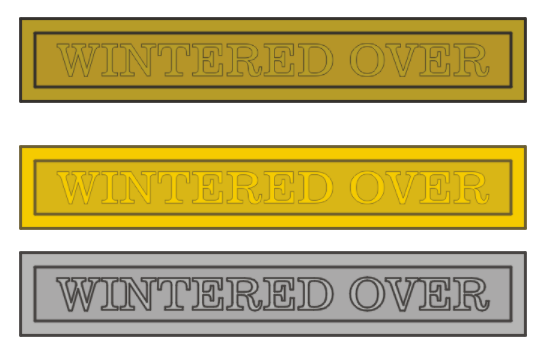
A clasp bearing the words "WINTERED OVER" for wear on the suspension ribbon of the medal awarded in bronze for the first winter, in gold for the second winter, and in silver for the third winter. The clasp is 1 1/4 inches (3.18cm) by 1/4 inch (.64cm) with raised letters within a 1/32 inch (.08cm) rim.
Army of Occupation Medal Clasps

The clasp is a bronze bar 1/8 inch (.32cm) by 1 1/2 inches (3.81cm) with the word "GERMANY" or "JAPAN" inscribed thereon, to denote occupation duty rendered in Europe and/or the Far East.
Arrowhead
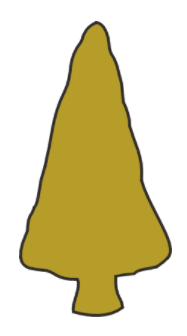
The arrowhead is a bronze replica of an Indian arrowhead 1/4 inch (.64cm) high. It denotes participation in a combat parachute jump, helicopter assault landing, combat glider landing, or amphibious assault landing, while assigned or attached as a member of an organized force carrying out an assigned tactical mission. A soldier must actually exit the aircraft or watercraft to receive assault credit. Individual assault credit is tied directly to the combat assault credit decision for the unit to which the soldier is attached or assigned at the time of the assault. Should a unit be denied assault, no assault credit will accrue to the individual soldiers of the unit. It is worn on the service and suspension ribbons of the Asiatic-Pacific Campaign, European-Africa-Middle Eastern Campaign, Korean Service Medal, Vietnam Service Medal and Armed Force Expeditionary Medal. Only one arrowhead will be worn on any ribbon.
Berlin Airlift Device
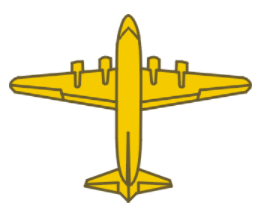
A gold color metal miniature of a C-54 type aircraft of 3/8 inch (.95cm) wingspan. The device is awarded to indicate 90 days consecutive service between 26 Jun 1948 and 30 Sep 1949. It is worn on the service and suspension ribbons of the Army of Occupation Medal.
Good Conduct Medal Clasps
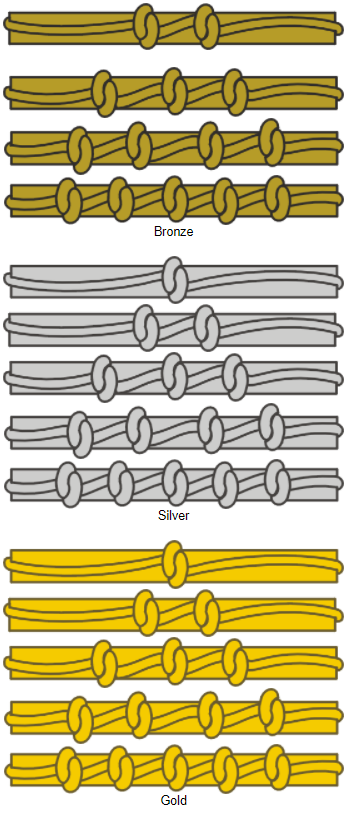
A 1/8 inch (.32cm) by 1 3/8 inches (3.49cm) bar of bronze, silver or gold, with loops indicative of each period of service. The bronze clasps are worn for the 2d through 5th award; silver 6th through 10th award; gold 11th through 15th award respectively.
Numerals
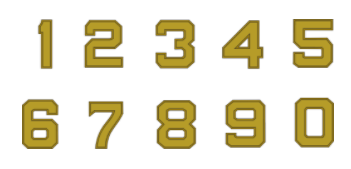
Arabic numerals 3/16 inch (.48cm) in height are issued instead of a medal or ribbon for second and subsequent awards of the Air Medal, Multinational Force and Observers Medal, Overseas Service Ribbon and the Army Reserve Components Overseas Training Ribbon. The ribbon denotes the first award and numerals starting with the numeral 2 denote the additional awards. The numeral worn on the NCO Professional Development Ribbon will denote the highest completed level of NCO development. The numerals are to be centered on the suspension ribbon of the medal or the ribbon bar.
Oak Leaf Clusters
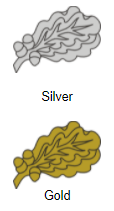
A bronze or silver twig of four oak leaves with three acorns on the stem, 13/32 inch (1.03cm) long for the suspension ribbon, and 5/16 inch (.79cm) long for the service ribbon bar and the unit award emblem is issued to denote award of second and succeeding awards of decorations (other than the Air Medal), the Army Reserve Components Achievement Medal, and unit awards. A silver Oak Leaf Cluster is worn instead of five Bronze Oak Leaf Clusters. Oak Leaf Clusters are not issued for the Legion of Merit awarded in degrees to foreign nationals. The 5/16 inch (.79cm) Oak Leaf Clusters joined together in series of 2, 3, and 4 clusters are authorized for optional purchase and wear of service ribbons and unit award emblems.
Service Stars
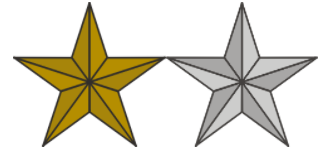
Service stars are worn on campaign and service ribbons to denote an additional award. The service star is a bronze or silver five-pointed star 3/16 inch (.48cm) in diameter. A silver star is worn instead of five bronze service stars. The bronze star is also affixed to the parachutist badge to denote participation in a combat parachutist jump, retroactive to 7 Dec 1941. Service stars are authorized for wear on the following campaign and service medals and or ribbons: World War I Victory Medal, American Defense Service Medal, American Campaign Medal, Asiatic-Pacific Medal, European-African-Middle Eastern Campaign Medal, Korean Service Medal, Vietnam Service Medal, National Defense Service Medal,, Humanitarian Service Medal, Prisoner of War Medal, Southwest Asia Service Medal, Military Outstanding Volunteer Service Medal and Armed Forces Expeditionary Medal.
Ten-Year Service

A bronze, silver and gold hourglass with Roman numeral "X" superimposed 5/16 inch (.79cm) in height to be worn on the service and suspension ribbon of the Armed Forces Reserve Medal. The bronze hourglass indicates 10 years service; silver hourglass indicates 20 years service; gold hourglass indicates 30 years service.
World War I Victory Medal Campaign Clasps
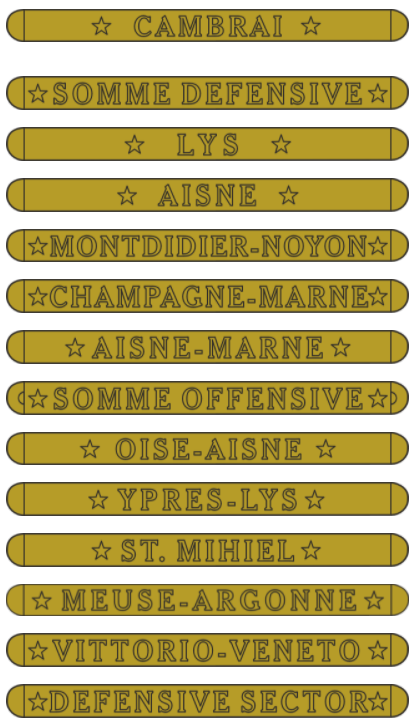
The battle clasp is a bronze bar 1/8 inch (.32cm) by 1 1/2 inches (3.81cm) with the name of the campaign or words "Defensive Sector," with a star at each end of the inscription. The battle clasp was awarded for each of the major operations for individuals actually present under competent orders.
World War I Victory Medal Service Clasps
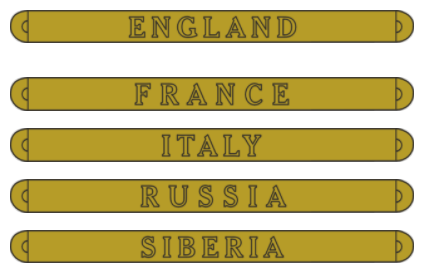
The service clasp is a bronze bar 1/8 inch (.32cm) by 1 1/2 inches (3.81cm) with the name of the country which the service was performed inscribed thereon. The service clasp was awarded to personnel who served overseas in a specific area that were not entitled to a battle clasp.
"M" Device

The "M" device is a bronze block letter, M, 1/4 inch (.64cm) in height. It is worn on the Armed Forces Reserve Medal to indicate mobilization in support of US Military operations or contingencies designated by the Secretary of Defense.
"V" Device

The "V" device is a bronze block letter, V, 1/4 inch (.64cm) high with serifs at the top of the members. It is worn to denote participation in acts of heroism involving conflict with an armed enemy. It was originally worn only on the suspension and service ribbons of the Bronze Star Medal to denote an award for heroism (valor). Effective 29 Feb 1964, the "V" device was also authorized for wear on the Air Medal and Army Commendation Medal for heroic acts or valorous deeds not warranting awards of the Distinguished Flying Cross or the Bronze Star Medal with "V" device. Effective 25 Jun 1963, the "V" device was authorized additionally for wear on the Joint Service Commendation Medal when the award is for acts of valor (heroism) during participation in combat operations. In the case of multiple "V" devices for the same award, only one "V" device is worn on the service ribbons.